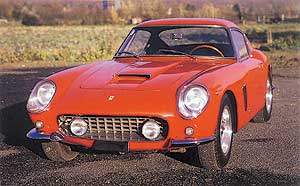SCM Analysis
Detailing
This 250 GT SWB Berlinetta sold for $829,794 at Bonhams’ Gstaad, Switzerland, auction on December 19, 2003.
Michael Lepeltier had built a 14-car Ferrari collection from the proceeds of his small family run garage. The collection included a 275 GTS, GTB and GTB 4-Cam. It also featured a 288 GTO and a Daytona, among an impressive selection of other Ferraris. The crown jewel was this 1961 250 GT SWB Berlinetta. How it and the rest of his collection came to be auctioned off last December is nothing short of a tragedy.
On April 19, 1990, Lepeltier and his wife arrived home in his recently purchased Ferrari F40. Waiting for them were two young men, there to steal the F40. When Lepeltier resisted, they shot him dead.
After the murder, the family business fell on hard times and his widow was forced to declare bankruptcy. The creditors got into a fight over the Ferraris and it was not until 13 years later that the attorneys agreed to liquidate the cars. During this time, the Ferraris sat in a secure warehouse, without turning a wheel. Ironically enough, the murderers, who were juveniles at the time of the crime, were released from prison before the cars were freed.
S/N 2649 has been thoroughly researched by Swiss Ferrari historian Marcel Massini, who found a clean history with original ownership in Rome. The 1961 Berlinetta was unique in that the purchaser ordered it built with many custom features, including a leather-covered dash, a center console, special instrumentation, electric windows and “perfect panel fit.”
The second owner was Gordon Scott, an American actor who owned a restaurant in Rome, and kept the 250 GT at his home there. It then went through a succession of owners before being passed along to Lepeltier in ’71.
Sometime during the period directly before Lepeltier’s ownership, the car was modified to a covered headlight configuration. While the auction catalog noted the modification was complementary to the rest of the car’s unique features, it’s worth noting that Ferrari never built a covered-headlight SWB. So while indeed unique, the headlight modification was not authentic and quite controversial.
Perhaps the headlight treatment turned off a few buyers, or maybe it was the SWB’s extended storage, but the result was a sale price below the expected $890,000, and less than other recent sales, including $902,000 paid for S/N 2549 at RM’s Arizona auction in 2002. This car, with its factory special features and such a documented history, should have been worth more money, perhaps over $1 million. Without too much trouble, the new owner could return the car to its original configuration, freshen it up, and probably turn a profit in the process.
There’s no doubt that we’ll be seeing more of 2649, as it sold to a true Italian Ferrari enthusiast who is actively involved with vintage events, and a long time SCM’er. He is reportedly planning on having the SWB Berlinetta restored; my prediction is when we next see the car, it will be immaculate, properly done, and with a nose restored to its original configuration.-Steve Ahlgrim
(Photos, historical and descriptive information courtesy of the auction company.)
